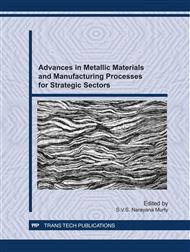p.427
p.433
p.439
p.445
p.451
p.457
p.463
p.471
p.477
Fracture Mechanics of Conventional and Narrow Groove Pulse Current Gas Metal Arc Welds of HSLA Steel
Abstract:
Mechanical and fracture properties of 20MnMoNi55 grade high strength low alloy (HSLA) steel welds have been studied. The weld joints were made using Gas Tungsten Arc Welding (GTAW), Shielded Metal Arc Welding (SMAW) and Pulse Gas Metal Arc Welding (P-GMAW) methods on conventional V-groove (V-Groove) and Narrow groove (NG-13). The base metal and weld metal were characterised in terms of their metallurgical, mechanical and fracture toughness properties by following ASTM procedures. The J-Integral fracture test was carried out using compact tension C(T) specimen for base and weld metal. The fracture toughness and tensile properties of welds have been correlated with microstructure. In conventional V-groove welds prepared by P-GMAW shows the improvement in initiation fracture toughness (JIC) as compared to the weld prepared by SMAW. Similar improvements in tensile properties have also been observed. This is attributed to reduction in co-axial dendrite content due to lower heat input during P-GMAW process as compared to SMAW. In the narrow groove P-GMA weld prepared at f value of 0.15 has shown relative improvement of JIC as compared to that of the weld prepared by SMAW process.
Info:
Periodical:
Pages:
451-456
Citation:
Online since:
January 2012
Authors:
Keywords:
Price:
Сopyright:
© 2012 Trans Tech Publications Ltd. All Rights Reserved
Share:
Citation:


